Certain distress equipment is required to be carried onboard pleasure craft at all times. This is so that you have it in the event of an emergency situation like a collision, a medical emergency or a mechanical breakdown. Situations like these, where you may require the use of a flare, are often unexpected, but if they happen to you, you’ll be happy to have the distress equipment when you need it most.
Watertight Flashlights
Most craft are required to carry one watertight flashlight onboard at all times. In an emergency, a flashlight can be used for illumination or to send a distress signal. To be approved, the batteries must be in good condition. A watertight flashlight qualifies as navigation lights on non-powered vessels less than 7 m in length.
Safe Boating Tip
You can signal your need for help by flashing S.O.S.: three short flashes, then three long flashes, followed by three short flashes.
Flares
Flares and pyrotechnic devices are used to signal distress and need of assistance. They should always be stored in a watertight container and located in a cool, dry, accessible area. You may be required to carry certain types of flares onboard your boat depending on:
- The size and type of boat
- The body of water on which you are operating
For example:
- You are required to carry flares if operating on any ocean or if operating on a waterway where you may be further than 1 nautical mile from shore
- You are not required to carry flares if you are operating on a river, canal or lake on which at no time your boat can be more than 1 nautical mile from shore
Using Flares
All flares and pyrotechnic distress signals must be approved for use by Transport Canada and are valid for only four years from their date of manufacture. Flares or other pyrotechnic devices should always be used with caution and kept out of the reach of children. Always follow the manufacturer’s instructions located on the packaging or casing before using a flare.
It is illegal to test or discharge a flare if it is not being used for an emergency situation and you should only dispose of flares in an approved manner. Contact your manufacturer, local law enforcement agency, fire department or the Canadian Coast Guard for proper disposal procedures.
Types of Approved Flares
There are four types of flares approved to signal your need for help:
1) Type A: Parachute Flare
- Easily seen from water, land and air
- Must emit a red light
2) Type B: Multi-Star Flare
- Easily seen from water, land and air
- Must emit a red light
3) Type C: Hand-Held Flare
- Not as easily seen from afar but effective for pinpointing your position
- Must emit a red light
4) Type D: Smoke Flare
- Highly visible during daylight hours
- Must give off orange smoke



